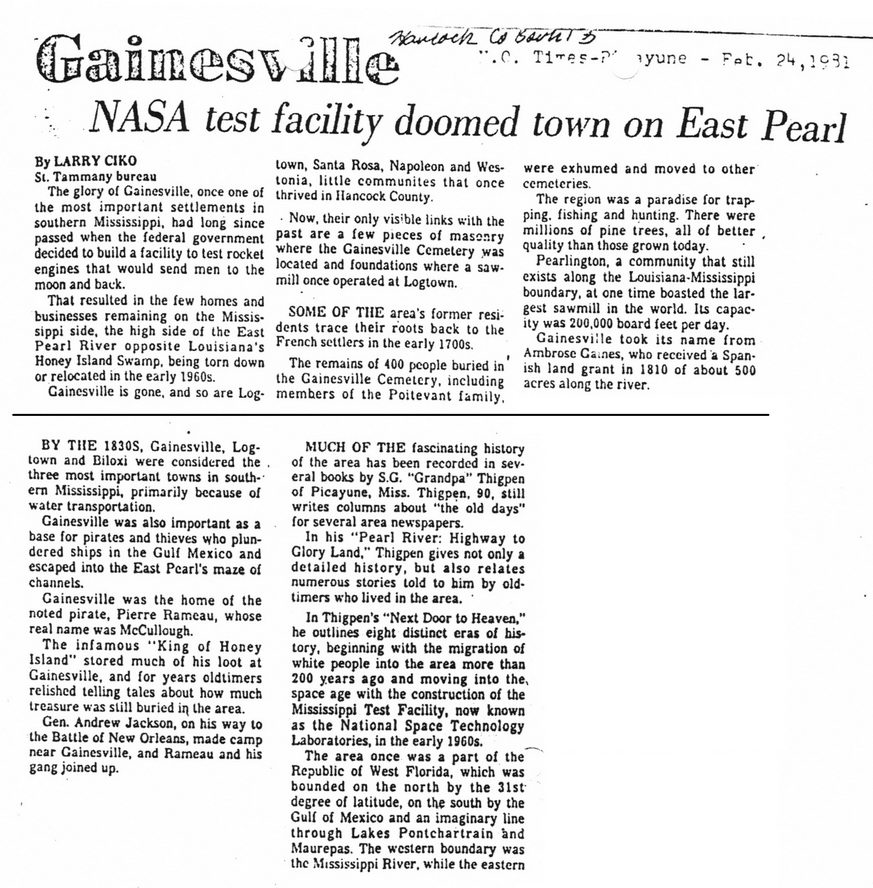This text was obtained via automated optical character recognition.
It has not been edited and may therefore contain several errors.
NASA test facility doomed town on East Pear] By LARRY CiKO Si. Tammany bureau The glory of Caincsviile, once one of the most important settlements in southern Mississippi, had long since passed when the federal government decided to build a facility to test rocket engines that would send men to the moon and back. That resulted in the few homes and businesses remaining on the Mississippi side, the high side of the East Pearl River opposite Louisiana's Honey Island Swamp, being torn down or relocated in the early 1960s. Caincsviile is gone, and so are Log- lown, Santa Rosa, Napoleon and Wcs-lonia, little communites that once thrived in Hancock County. ■ Now, their only viS'ble links with the past are a few pieces of masonry where the Gainesville Cemetery was located and foundations where a sawmill once operated at Loglown. SOME OF THE area's former residents trace their roots back to the French settlers in the early 1700s. The remains of 400 people buried in the Gainesville Cemetery, including members of the Poitevant family, were exhumed and moved to other ccmetcries. The region was a paradise for trapping. fishing and hunting. There were millions of pine trees, all of better quality than those grown today. Pearlington, a community that still exists along the Louisiana-Mississippi boundary, at one time boasted the largest sawmill in the world. Its capacity was 200,000 board feet per day. CainesviMe took its name from Ambrose Carnes, who received a Spanish land grant in 1810 of about 500 acres along the river. BY THE 1830S, Gainesville. Log-town and Biloxi were considered the three most important towns in south-' era Mississippi, primarily bccause of water transportation. Gainesville was also important as a base for pirates and thieves who plundered ships in the Gulf Mexico and escaped into the East Pearl's maze of channels. Gainesville was the home of the noted pirate, Pierre Rameau, whose real name was McCullough. The infamous "King of Honey Island" stored much of his loot at Gainesville, and for years oldtimers relished telling tales about how much treasure was still buried ii\ the area. Gen. Andrew Jackson, on his way lo the Battle of New Orleans, made camp near Gainesville, and Rameau and his gang joined up. MUCH OF THE fascinating history of the area has been recorded in several books by S.G. “Grandpa" Thigpen of Picayune, Miss. Thigpen, 90, still writes columns about "the old days" for several area newspapers. In his ‘‘Pearl River: Highway to Glory Land," Thigpen gives not only a detailed history, but also relates numerous stories told to him by old-timers who lived in the area. In Thigpen’s “Next Door to Heaven,” he outlines eight distinct eras of history, beginning with the migration of white people into the area more than 200 years ago and moving into the, space age with the construction of the Mississippi Test Facility, now known as the National Space Technology Laboratories, in the early 1960s. The area once was a part of the Republic of West Florida, which was bounded on the north by the 31st degree of latitude, on the south by the Gulf of Mexico and an imaginary line through Lakes Pontchartrain fend Maurepas. The western boundary was the Mississippi River, while the eastern

Gainesville NASA-Test-Facility-Doomed-Town-on-East-Pearl